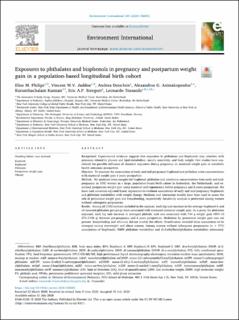| dc.contributor.author | Philips, Elise M. | |
| dc.contributor.author | Jaddoe, Vincent V.W. | |
| dc.contributor.author | Deierlein, Andrea | |
| dc.contributor.author | Asimakopoulos, Alexandros | |
| dc.contributor.author | Kannan, Kurunthachalam | |
| dc.contributor.author | Steegers, Eric A.P. | |
| dc.contributor.author | Trasande, Leonardo | |
| dc.date.accessioned | 2022-09-02T09:45:48Z | |
| dc.date.available | 2022-09-02T09:45:48Z | |
| dc.date.created | 2021-01-19T21:37:43Z | |
| dc.date.issued | 2020 | |
| dc.identifier.citation | Environment International. 2020, 144 . | en_US |
| dc.identifier.issn | 0160-4120 | |
| dc.identifier.uri | https://hdl.handle.net/11250/3015358 | |
| dc.description.abstract | Background
Experimental evidence suggests that exposures to phthalates and bisphenols may interfere with processes related to glucose and lipid metabolism, insulin sensitivity, and body weight. Few studies have considered the possible influence of chemical exposures during pregnancy on maternal weight gain or metabolic health outcomes postpartum.
Objective
To examine the associations of early and mid-pregnancy bisphenol and phthalate urine concentrations with maternal weight gain 6 years postpartum.
Methods
We analyzed urine samples for bisphenol, phthalate and creatinine concentrations from early and mid-pregnancy in 1192 women in a large, population-based birth cohort in Rotterdam, the Netherlands, and examined postpartum weight gain using maternal anthropometrics before pregnancy and 6 years postpartum. We have used covariate-adjusted linear regressions to evaluate associations of early and mid-pregnancy bisphenols and phthalate metabolites with weight change. Mediator and interaction models have been used to assess the role of gestational weight gain and breastfeeding, respectively. Sensitivity analysis is performed among women without subsequent pregnancies.
Results
Among all 1192 mothers included in the analysis, each log unit increase in the average bisphenol A and all assessed phthalate groupings were associated with increased maternal weight gain. As a proxy for phthalate exposure, each log unit increase in averaged phthalic acid was associated with 734 g weight gain (95% CI 273–1196 g) between pre-pregnancy and 6 years postpartum. Mediation by gestational weight gain was not present. Breastfeeding and ethnicity did not modify the effects. Stratification revealed these associations to be strongest among overweight and obese women. Among women without subsequent pregnancies (n = 373) associations of bisphenols, HMW phthalate metabolites and di-2-ethylhexylphthalate metabolites attenuated. For phthalic acid, LMW phthalate metabolites and di-n-octylphthalate metabolites associations increased. Similarly to the whole group, stratification yielded significant results among overweight and obese women.
Discussion
In a large population-based birth cohort, early and mid-pregnancy phthalate exposures are associated with weight gain 6 years postpartum, particularly among overweight and obese women. These data support ongoing action to replace phthalates with safer alternatives. | en_US |
| dc.language.iso | eng | en_US |
| dc.publisher | Elsevier | en_US |
| dc.rights | Attribution-NonCommercial-NoDerivatives 4.0 Internasjonal | * |
| dc.rights.uri | http://creativecommons.org/licenses/by-nc-nd/4.0/deed.no | * |
| dc.title | Exposures to phthalates and bisphenols in pregnancy and postpartum weight gain in a population-based longitudinal birth cohort | en_US |
| dc.title.alternative | Exposures to phthalates and bisphenols in pregnancy and postpartum weight gain in a population-based longitudinal birth cohort | en_US |
| dc.type | Peer reviewed | en_US |
| dc.type | Journal article | en_US |
| dc.description.version | publishedVersion | en_US |
| dc.source.pagenumber | 9 | en_US |
| dc.source.volume | 144 | en_US |
| dc.source.journal | Environment International | en_US |
| dc.identifier.doi | 10.1016/j.envint.2020.106002 | |
| dc.identifier.cristin | 1874953 | |
| cristin.ispublished | true | |
| cristin.fulltext | original | |
| cristin.qualitycode | 1 | |

